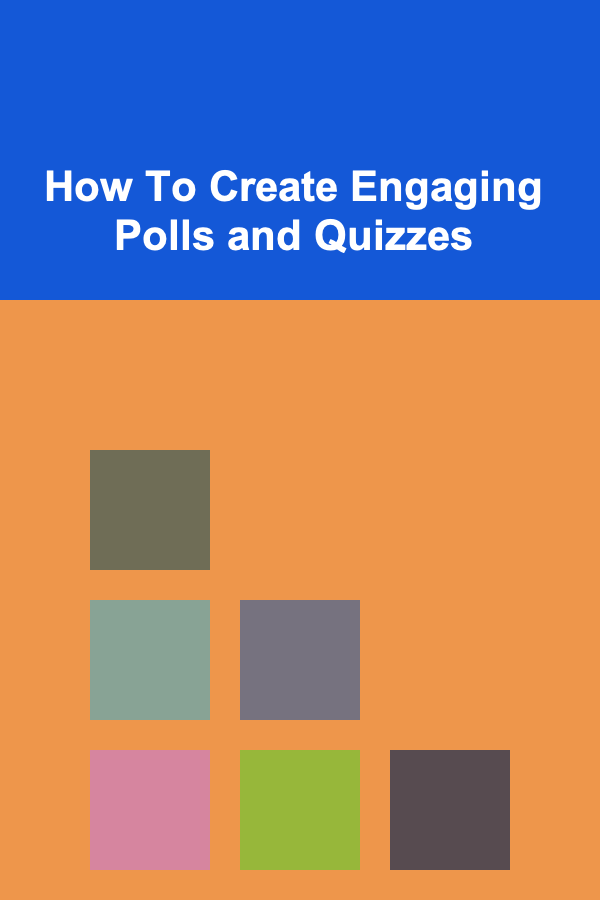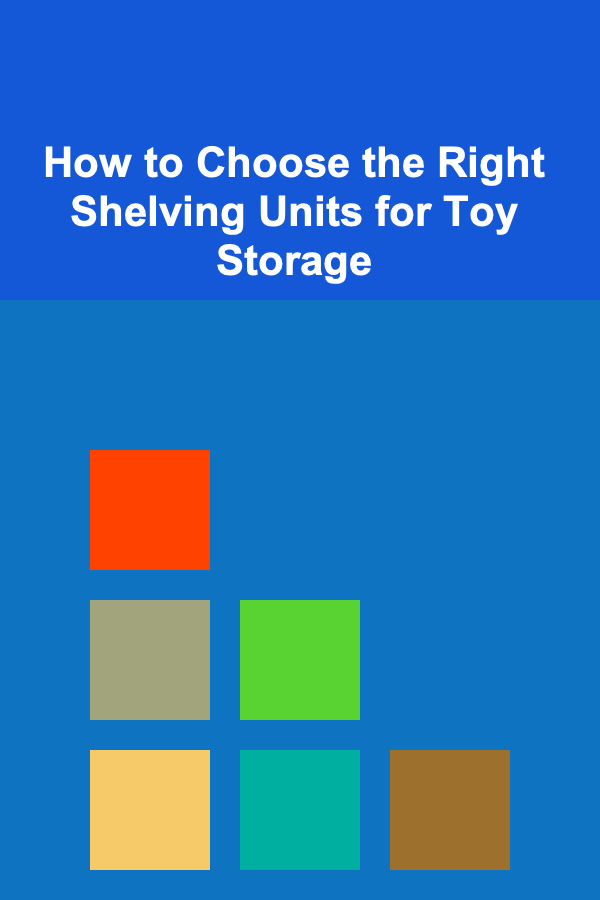
How To Create Engaging Polls and Quizzes
ebook include PDF & Audio bundle (Micro Guide)
$12.99$11.99
Limited Time Offer! Order within the next:

Creating engaging polls and quizzes is a fantastic way to capture the attention of your audience, gather valuable insights, and entertain participants. Whether you're conducting market research, gathering feedback, or simply looking to entertain, polls and quizzes can create an interactive experience that fosters engagement. However, designing these tools in a way that maximizes participation, enjoyment, and results requires more than just creating questions and answers. To truly engage your audience, you need a strategy that takes into account their preferences, motivations, and interests.
In this article, we will explore the key steps and best practices for creating engaging polls and quizzes that resonate with your audience. From crafting compelling questions to utilizing data analysis, we will walk through everything you need to know to create a highly engaging and successful poll or quiz.
Understand Your Purpose
Before diving into the creation of a poll or quiz, it's essential to understand why you're creating it. Whether it's for entertainment, education, feedback collection, or market research, the purpose will guide every other aspect of the design process. A well-defined goal will help you choose the right format, tone, and delivery method for your quiz or poll.
Types of Polls and Quizzes
- Entertainment Quizzes: These types of quizzes are designed to engage and entertain, often by answering light-hearted or fun questions. Think personality quizzes, trivia, and "which [something] are you" quizzes. The goal is primarily to keep users entertained.
- Market Research Polls: These polls are often used to gather valuable feedback from customers or audiences. The questions are typically straightforward and designed to gauge opinions, preferences, and behaviors.
- Educational Quizzes: These quizzes serve to educate, test knowledge, or reinforce learning. They can be used in classrooms, online learning environments, or self-assessment contexts.
- Survey Polls: These are in-depth and often require longer-form questions. They are designed to gather detailed data on specific topics, such as customer satisfaction or social issues.
Know Your Audience
Understanding your audience is crucial to creating an engaging poll or quiz. Different groups of people have different preferences, interests, and motivations for participating in quizzes and polls. The questions and design elements you choose will vary depending on your target demographic.
Audience Research
Before designing your poll or quiz, gather information about your audience. Consider these factors:
- Age Group: Different age groups engage differently with quizzes. Younger audiences may prefer short, visual quizzes with fun results, while older groups may lean towards more thoughtful, informative quizzes.
- Interests: What are the interests of your audience? If you're targeting a sports fanbase, a quiz about sports trivia might be popular. On the other hand, a quiz about movies or pop culture might resonate with a younger, entertainment-focused crowd.
- Cultural Sensitivity: Be mindful of cultural differences and ensure that your questions and answers are appropriate for all participants. A culturally sensitive quiz will avoid alienating any part of your audience.
By understanding your audience's preferences, you can tailor your poll or quiz to appeal directly to their interests and increase engagement.
Craft Engaging Questions
The core of any successful poll or quiz lies in the questions you ask. The best questions are those that spark curiosity, generate interest, and are easy to understand. Here are some tips for crafting questions that engage participants:
Keep It Simple and Clear
Ensure that your questions are easy to understand. Avoid complex jargon or phrases that may confuse participants. A simple, clear question is more likely to get answered.
For example:
- Good Question: "What's your favorite color?"
- Bad Question: "Which of the following chromatic hues do you associate with emotional warmth and tranquility?"
Make Questions Fun
Quizzes are meant to be enjoyable, so inject some fun into the questions. Humorous, light-hearted questions often generate more engagement. If you're creating a quiz for entertainment purposes, consider making questions quirky or relatable to your audience's everyday experiences.
Example:
- "Which type of pizza best represents your personality?"
- "What's your spirit animal? Find out now!"
Use a Mix of Question Types
Variety is the spice of life, and your poll or quiz will benefit from a mix of question formats. You can use multiple-choice, true/false, ranking, or even open-ended questions to keep things interesting.
- Multiple-choice: These are the most common type of questions, where participants choose from a list of predefined options.
- True/False: Simple and quick to answer, these questions can be fun when paired with tricky facts.
- Ranking: Ranking questions ask participants to order items by preference or importance. These can lead to more engaging discussions and interesting insights.
- Open-ended: These questions encourage participants to think and provide a more detailed response. While they may take longer to answer, open-ended questions can yield valuable qualitative data.
Provide Clear Answer Choices
For multiple-choice questions, it's essential to offer answer choices that are clear, balanced, and relevant to the question. Avoid providing answer choices that are too extreme, as they can skew the results.
Example:
- Unbalanced Choices: "Are you an incredible genius or a complete idiot?"
- Balanced Choices: "Do you consider yourself a fast learner or someone who takes their time?"
Add Personalization and Results
Especially in quizzes designed for entertainment, adding a personalized outcome can significantly increase engagement. At the end of the quiz, provide results that feel custom-tailored to the participant's answers. For example, if you're creating a personality quiz, you could reveal the participant's "type" or provide a fun description based on their answers.
Use Visuals to Enhance Questions
Visual elements like images, GIFs, and videos can significantly increase engagement. Visuals break up the monotony of text and make quizzes more interactive. For example, a "Which movie character are you?" quiz could feature images of the characters.
Keep It Short and Sweet
In today's fast-paced world, attention spans are short. To keep participants engaged, aim to keep your polls and quizzes short. The best quizzes are typically between 5 and 10 questions long. Any longer, and participants may lose interest.
For polls, aim for one or two questions to maintain brevity.
Progress Bars and Skip Options
If your quiz is a bit longer, consider adding a progress bar to indicate how much of the quiz has been completed. This can motivate users to finish. Additionally, provide a skip or "next" button to allow participants to move through the quiz at their own pace.
Optimize for Mobile
With the increasing use of mobile devices, ensuring that your polls and quizzes are mobile-friendly is essential. Design your quizzes to be responsive, meaning they automatically adjust to fit various screen sizes, including smartphones and tablets.
Mobile Design Tips
- Large Buttons and Easy Navigation: Ensure buttons are large enough to tap easily on a mobile device.
- Minimal Scrolling: Try to minimize the amount of scrolling required to complete the quiz. Keep questions and answers visible without forcing users to scroll too much.
- Fast Loading Times: Optimize images and content so your quiz loads quickly, even on slower mobile networks.
Add Social Sharing Options
To increase the reach of your quiz or poll, make it easy for participants to share their results on social media. Incorporate social sharing buttons that allow users to post their results on Facebook, Twitter, Instagram, or any other platform your audience uses.
The Power of Social Sharing
When users share their results on social media, it acts as free promotion for your poll or quiz. It's a great way to attract more participants, boost engagement, and reach new audiences.
Analyze and Use the Results
Once your poll or quiz has been completed, the real work begins: analyzing the results. Whether you're using the data for marketing, feedback, or research purposes, understanding what your participants have shared can provide invaluable insights.
Data Collection and Analysis Tools
There are various tools available to help you track responses and analyze data. Platforms like Google Forms, SurveyMonkey, and Typeform allow you to collect data efficiently. You can then use built-in analytics or export the data to tools like Excel or Google Sheets for deeper analysis.
Use Results to Improve Future Quizzes
The feedback and data you collect from polls and quizzes can be used to improve your future efforts. For example, if you notice that a particular question consistently confuses users or doesn't generate engagement, you can modify it for next time.
Conclusion
Creating engaging polls and quizzes is a powerful way to connect with your audience, gather insights, and entertain. By following the guidelines outlined above---understanding your purpose, crafting interesting questions, making it mobile-friendly, adding visual elements, and using social media sharing---you can create an interactive experience that captivates and motivates your participants.
Polls and quizzes are an excellent way to learn more about your audience, test their knowledge, and even drive traffic to your website or social media page. So, what are you waiting for? Start creating your own engaging quizzes and polls today!
Reading More From Our Other Websites
- [Home Storage Solution 101] How to Maximize Bathroom Storage with Over-the-Door Solutions
- [Home Party Planning 101] How to Plan a Bonfire Party with S'mores & Storytelling
- [Home Security 101] How to Create a Neighborhood Watch Program for Better Security
- [Organization Tip 101] How to Create a Simple Meal Prep Routine for Busy Days
- [Star Gazing Tip 101] Cosmic Myths Unveiled: How Legends Inspire Today's Star-Gazing Adventures
- [Home Security 101] How to Improve Home Security in an Apartment or Condo
- [Mindful Eating Tip 101] Cravings with Care: How to Stay Present and Balanced While Pregnant
- [Personal Investment 101] How to Invest in Peer-to-Peer Lending for Passive Income
- [Home Renovating 101] How to Estimate the True Sunroom Addition Cost Before You Start Planning
- [Mindful Eating Tip 101] Best Mindful Eating Rituals for Seniors

How to Choose the Right Shelving Units for Toy Storage
Read More
How to Extend the Life of Your Roof with Proper Maintenance
Read More
How to Serve Delicious Finger Foods for a Cocktail Party
Read More
How to Use Hidden Compartments to Save Space in Your Home
Read More
How to Use Task Lighting to Boost Productivity in Your Home Office
Read More
10 Productivity Hacks for Your Language Learning To-Do List
Read MoreOther Products

How to Choose the Right Shelving Units for Toy Storage
Read More
How to Extend the Life of Your Roof with Proper Maintenance
Read More
How to Serve Delicious Finger Foods for a Cocktail Party
Read More
How to Use Hidden Compartments to Save Space in Your Home
Read More
How to Use Task Lighting to Boost Productivity in Your Home Office
Read More